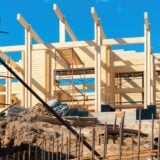But prices are still increasing with the data showing that the median existing home price for all housing types in February was $210,800, up 4.4% from February 2015. It was the 48th month in a row for price growth.
The data from the National Association of Realtors also shows that all four major regions saw sales fall, led by the Northeast and Midwest, with overall transactions down by 7.1%, the index report data shows, but sales are still 2.2% higher than a year ago.
‘Sales took a considerable step back in most of the country last month, and especially in the Northeast and Midwest,’ said Lawrence Yun, NAR chief economist.
Yun explained that a lull in contract signings in January from the large East Coast blizzard, along with the slump in the stock market, may have played a role in February's lack of closings.
‘However, the main issue continues to be a supply and affordability problem. Finding the right property at an affordable price is burdening many potential buyers,’ he added.
According to Yun, job growth continues to hum along at a robust pace, but there appears to be some uneasiness among households that the economy is losing some steam. This was evident in NAR's latest quarterly which revealed that fewer respondents believe the economy is improving, and a smaller share of renters said that now is a good time to buy a home.
‘The overall demand for buying is still solid entering the busy spring season, but home prices and rents outpacing wages and anxiety about the health of the economy are holding back a segment of would-be buyers,’ Yun pointed out.
The data also shows that total housing inventory at the end of February increased 3.3% to 1.88 million existing homes available for sale, but is still 1.1% lower than a year ago. Unsold inventory is at a 4.4 month supply at the current sales pace, up from four months in January.
All-cash sales were 25% of transactions in February, down from 26% both in January and a year ago. Individual investors, who account for many cash sales, purchased 18% of homes in February compared to 17% in January, matching the highest share since April 2014 while 64% of investors paid cash in February.
‘Investor sales have trended surprisingly higher in recent months after falling to as low as 12 percent of sales in August 2015. Now that there are fewer distressed homes available, it appears there's been a shift towards investors purchasing lower priced homes and turning them into rentals. Already facing affordability issues, this competition at the entry level market only adds to the roadblocks slowing first time buyers,’ Yun explained.
The share of first time buyers fell to 30% in February, matching the lowest share since November 2015, from 32% in January, but is up from 29% a year ago. First time buyers in all of 2015 represented an average of 30%.
Properties typically stayed on the market for 59 days in February, a decrease from 64 days in January and below the 62 days in February 2015. Short sales were on the market the longest at a median of 126 days in February, while foreclosures and non-distressed homes each took 57 days. Some 35% of homes sold in February were on the market for less than a month.
NAR president Tom Salomone, revealed that many real estate agents are saying instances of multiple bids and affordable homes going under contract quickly are common in their markets.
‘With low supply this spring buying season, it's easy for buyers to get discouraged when their offer is rejected in favour of a higher bid,’ he said.
Matching the highest share since May 2015, distressed sales, including foreclosures and short sales, rose slightly to 10% in February, up from 9% in January but down from 11% a year ago. Some 7% of February sales were foreclosures and 3% were short sales.
Foreclosures sold for an average discount of 17% below market value in February compared with 13% in January, while short sales were discounted 16% compared to 12% in January.





